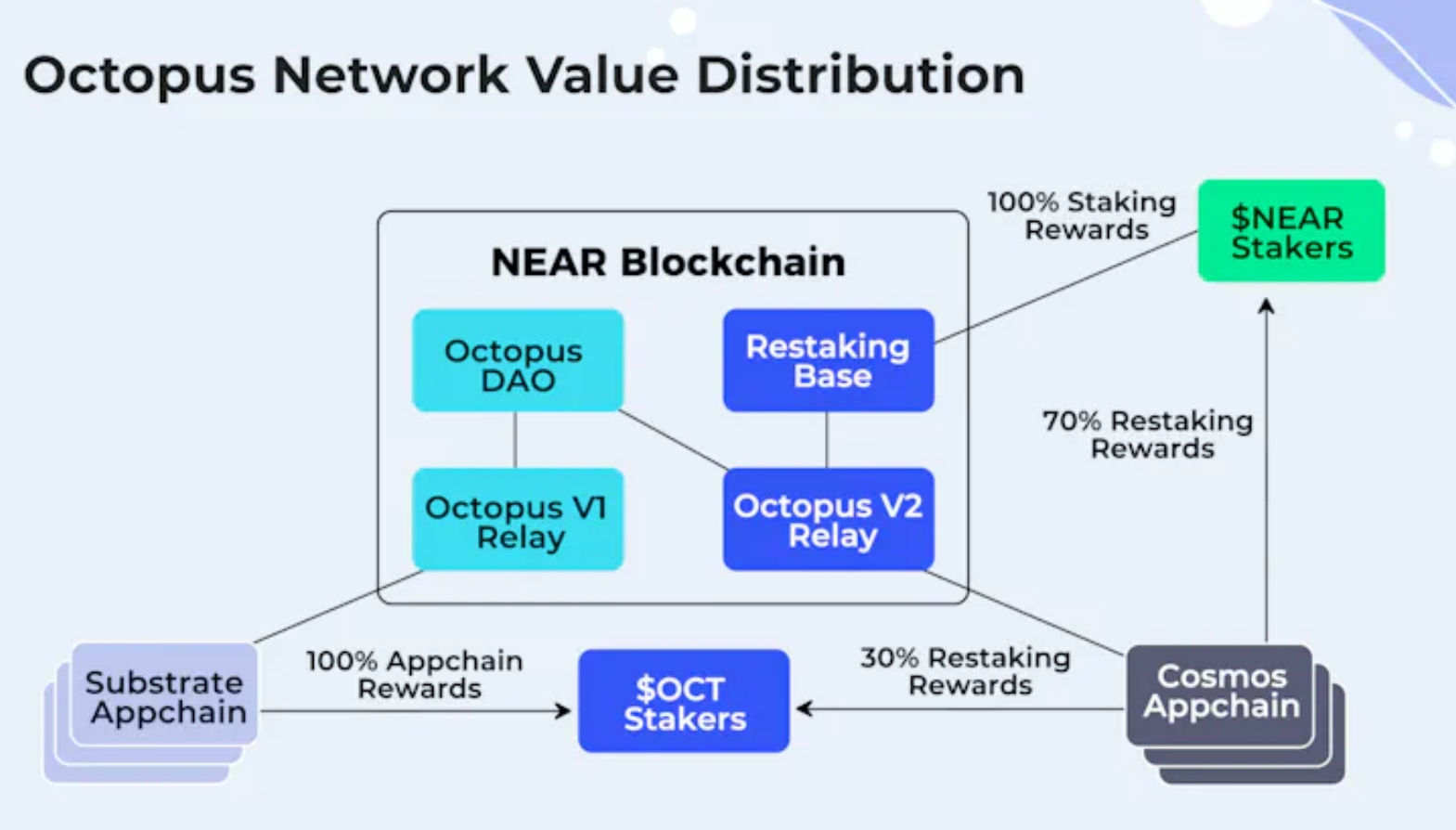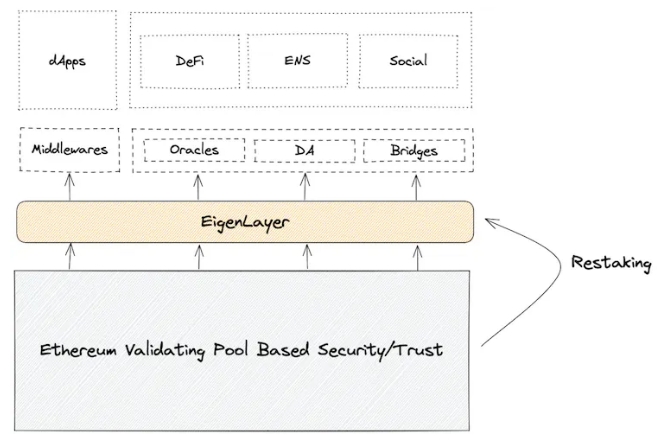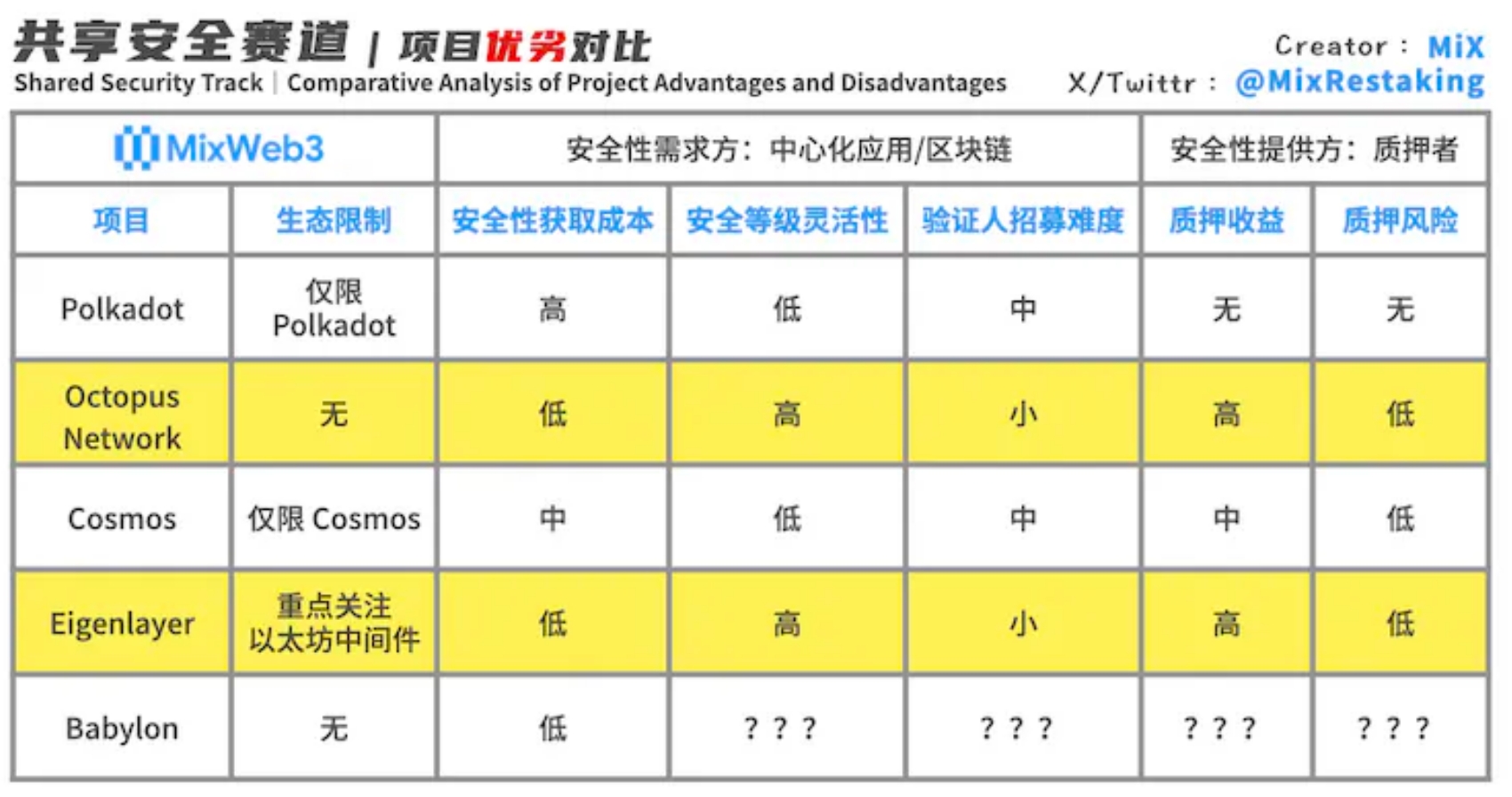Shared Security: Enabling "Decentralized Trust" to be Transacted
Author: @MixRestaking
Source: MixWeb3
Shared security means that one or more blockchains can enhance their own security by sharing the "decentralized trust source" of another blockchain, achieving decentralized launch and operation. This lowers the startup threshold and operational costs for blockchains starting from scratch and helps prevent oligarchic control, allowing teams to focus more on value innovation in Web3.
It is well known that blockchains are machines of trust, and the fundamental value of a blockchain is decentralized trust. Public chains have always been in the spotlight because their business model is to provide decentralized trust for smart contracts on their own chain.
In other words, decentralized trust is a service that public chains provide to smart contracts, and the gas we pay during on-chain interactions is the cost for this decentralized trust. It is estimated that the vast majority of people are unaware of this essence of public chains, which is why the entire public chain sector can have a valuation exceeding one trillion dollars.
The shared security service aims to extend "decentralized trust" from one blockchain to more blockchains, allowing decentralized trust that originally had to be self-built through PoW/PoS to become a third-party service that can be flexibly purchased at any time.
Thus, decentralized trust has for the first time become as flexibly rentable as cloud computing and cloud storage, becoming part of the operational costs of Web3 projects rather than a goal. Teams can focus more on business innovation itself.
At the same time, decentralized trust bears the security of the chain. As the number of blockchains and on-chain assets increases, the market scale of decentralized trust will become extremely large, and I believe its scale will start at least in the hundreds of billions of dollars.
Currently, well-known projects in the shared security sector include Polkadot, Octopus Network, Cosmos, EigenLayer, and Babylon. These projects have their own unique solutions, and their advantages and disadvantages cannot be generalized; they should be understood in the context of their respective eras and vertical scenarios.
Polkadot
The "self-selling model" of decentralized trust, sold only to "Polkadot ecosystem parachains"

Polkadot shared security architecture diagram
Founded in 2016, Polkadot was one of the first projects to propose and implement shared security.
Polkadot's shared security mechanism allows parachains to bid for slots to connect to the relay chain, with the security provided by the validating nodes of the relay chain, thus obtaining the same level of security as the relay chain. This solution allows Substrate chains to directly gain security worth billions of dollars from Polkadot, solving the long bootstrap time for the security of new blockchains. However, because they can only choose the very high level of security from Polkadot, combined with the auction mechanism, it results in high startup costs for new chains, which is very unfriendly to startup projects that have limited financial resources and team energy.
Recent practices have shown that the vast majority of Polkadot parachains do not require such a high level of security. The two-year exclusive slot mechanism has also led to very low utilization efficiency of the relay chain's "decentralized trust" resources, and it is clear that Polkadot has recognized this issue.
On June 28, 2023, Polkadot 2.0 aimed to construct a more flexible allocation method for decentralized trust resources in terms of time cycles and security levels. Based on the "block space" as the minimum unit resource of the relay chain, Substrate chains can use DOT to purchase the quantity and duration of "block space" as needed, achieving flexible access to decentralized security.
On October 25, the testnet Rococo of the Polkadot relay chain has already implemented the ability to purchase relay chain block space on demand, and testing is being prepared. The "agile core time" that replaces "slots" is expected to be realized in the first or second quarter of 2024.
It can be seen that Polkadot treats its own relay chain's decentralized trust as a commodity, selling it to Substrate chains that join the ecosystem, whether it is the DOT staking of the 1.0 era or the purchasing in the 2.0 era.
In fact, Polkadot is the only project in the entire shared security sector that chooses to sell decentralized trust directly.
Octopus Network
A bilateral market for decentralized trust, focusing on serving application chains without ecological restrictions
Founded in 2019, Octopus Network focuses on providing shared security services for application chains, pioneering the LPoS rental proof-of-stake mechanism.
Octopus Network has built a bilateral market for buying and selling the security of decentralized trust, where application chains are both the demand and purchasing party for security, using native tokens as rent paid to validator nodes, which are the providers of decentralized trust security. The underlying logic of Octopus Network's security bilateral market essentially lays the foundation for the basic paradigm of subsequent shared security services.

Octopus Network shared security architecture diagram
- In the V1 phase of Octopus Network, validators of Substrate application chains stake $OCT from Octopus Network to ensure the security of the application chain, meaning the application chain rents the shared security of Octopus Network's $OCT.
- In the V2 phase, based on V1, the $NEAR Restaking mechanism has been added, using $NEAR for Restaking to provide security for application chains based on the Cosmos SDK. It is planned to launch in the fourth quarter of 2023.
Essentially, Restaking is a shared security mechanism first proposed by Eigenlayer. It allows the same asset to be staked simultaneously on multiple "decentralized applications/blockchains" to provide security for them. Its groundbreaking innovation lies in maximizing the interests of "decentralized applications/blockchains," "blockchains providing shared security," and "stakers." >>> Click to view "Understanding Restaking in One Article"
The greatest advantage of Octopus Network's shared security solution is its focus and flexibility. It solves the high bootstrap costs and long cycles of security in the original PoS mechanism, and the addition of $NEAR Restaking in the V2 era further elevates the level of security that can be provided to the billion-dollar level.
- Focused on serving a single application chain.
- Flexible in the choice of security levels.
In fact, Octopus Network has already made NEAR a highly competitive blockchain internet hub, becoming a significant potential competitive force for NEAR.
Cosmos
A bilateral market for decentralized trust governed by the Cosmos community
Cosmos was founded in 2014 and was the first to propose the concept of a multi-chain network. However, it wasn't until March 15, 2023, that it released the Replicated Security mechanism, filling the gap in shared security solutions.

Consumer Chain applying the replicated security mechanism to obtain security
The core logic of Cosmos replicated security is to view all Cosmos validators as a whole. After community voting agrees to provide security for consumer chains, validators can use the $ATOM already staked in Cosmos to run validation nodes specifically for Cosmos ecosystem consumer chains, achieving decentralized security. This solution references the construction logic of the Octopus Network's bilateral market and also incorporates the Restaking concept proposed by Eigenlayer, but there are significant differences in flexibility, leading to two issues.
- The value of consumer chains needs to empower the Cosmos hub to gain enough votes for community consent. For example, Neutron, as the DeFi center of the Cosmos ecosystem.
- Consumer chains need to pay rent for security at the level of $2 billion for the Cosmos hub, which will inevitably bring significant economic pressure.
Recently, there was an interesting proposal in the Cosmos community: the liquidity staking project Stride, based on replicated security, proposed to merge into the Cosmos Hub, converting all $STRD into $ATOM, becoming a satellite chain of the Cosmos Hub. Although it eventually came to nothing, it cast a shadow over the replicated security solution.
EigenLayer
A bilateral market for decentralized trust serving Ethereum middleware
Founded in 2021, EigenLayer brings Ethereum-level trust into middleware: allowing ETH already staked on Ethereum to be restaked on Ethereum middleware, sharing Ethereum's nearly unshakeable economic security. EigenLayer first proposed the Restaking mechanism, which is also the source of the idea for the $NEAR Restaking mechanism mentioned in the Octopus Network's 2.0 version.

EigenLayer's Restaking infrastructure
Its advantages mainly lie in two aspects:
- Focused on shared security solutions for Ethereum middleware, filling the gaps in the economic security of the entire Ethereum ecosystem.
- Flexible adjustment of security levels, allowing middleware protocols to flexibly acquire and adjust staking amounts and security levels according to their different developmental stages.
Babylon
A bilateral market for decentralized trust based on BTC | possessing the largest decentralized trust pool
Founded in 2022, Babylon focuses on Bitcoin. Babylon is an independent PoS blockchain that allows Bitcoin holders to stake and restake their Bitcoin through Babylon to blockchains that need security, earning security rewards; on the other hand, the blockchains that receive security guarantees also manage and control their security on Babylon.

Even in the current deep bear market, BTC is an asset worth over $500 billion, combined with the natural security advantages of PoW and the large amount of idle liquidity in BTC, this becomes Babylon's core value, possessing the undisputed largest decentralized trust pool in the blockchain world.
Analyzing Advantages and Disadvantages: Based on the Core Advantages of "Shared Security"

For new decentralized applications/blockchains (security demand side)
- Low cost of acquiring security, avoiding excessive issuance of application chain tokens that dilute value. It is well known that independent PoS usually requires an annual issuance of about 10% of tokens to reward the validator community, and high issuance dilutes token value, creating continuous selling pressure in the secondary market.
- Flexible adjustment of security levels. Blockchains can flexibly set the security level of application chains according to business scenarios and developmental stage needs. Generally, the security level can be lower in the early stages, and as the economic scale and asset scale of the application chain expand, on-chain governance can form a resolution to increase security rent, and then the technical team can adjust the block rewards of the application chain to quickly obtain a higher level of security.
- Low difficulty in recruiting validators, allowing for quicker blockchain launches. During the startup phase, there is no need for the native token to have value consensus before recruiting validators, which saves teams years of time and millions of dollars in funding, skipping the validator recruitment phase, saving time and effort, and achieving a rapid and secure launch of the application chain.
For stakers (security providers)
Lower staking risk Using $DOT, $OCT, $NEAR, $ATOM, or even more robust $ETH and $BTC with value consensus for staking, compared to staking the native tokens of application chains, the risk of asset devaluation is lower.
Higher staking rewards Restaking and replicated security mechanisms allow stakers to obtain multiple rewards.
In addition, there is actually an extremely important but not easily noticed deep advantage, which is "avoiding blockchain oligarchy."
The validator community of traditional PoS gradually controls most governance rights due to continuous token issuance, becoming oligarchs. They even propose votes to increase block rewards, increasing their income and the security costs of the chain. However, in blockchains that adopt shared security mechanisms, validator nodes do not stake native tokens with governance utility, fundamentally solving the problem of validator control over the blockchain. In blockchains that adopt shared security mechanisms, their validators are purely there to earn rewards, which does not affect the governance and decision-making of the nascent blockchain, thus avoiding the awkward situation of the blockchain being dominated by validators.
Innovation requires continuous iteration, with lower startup thresholds and trial-and-error costs.
The launch of new decentralized protocols and blockchains adopting shared security solutions will be a trend, as only by exponentially reducing the startup risks and operational costs of blockchains can we accelerate innovation in Web3 once again.
Thus, it is evident that shared security will undoubtedly become one of the most important infrastructure services in the crypto space.










